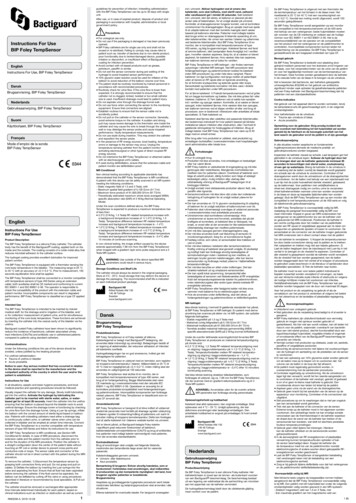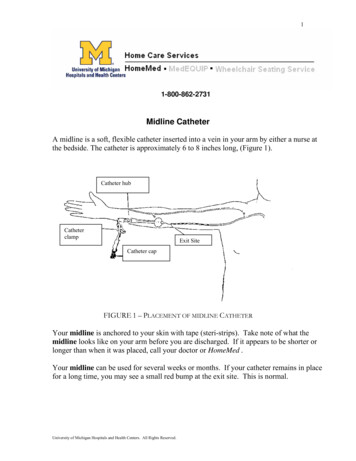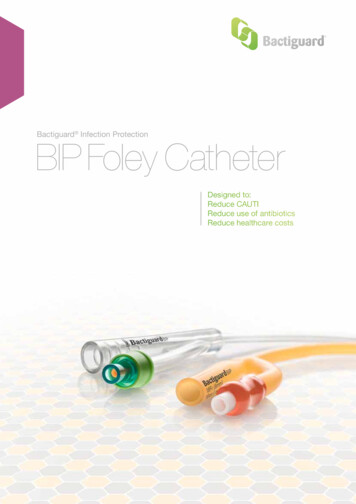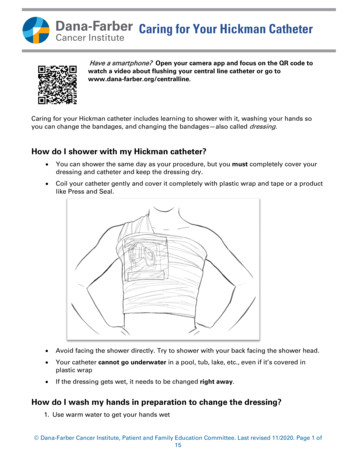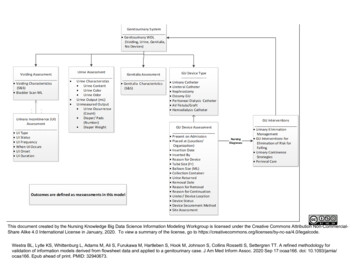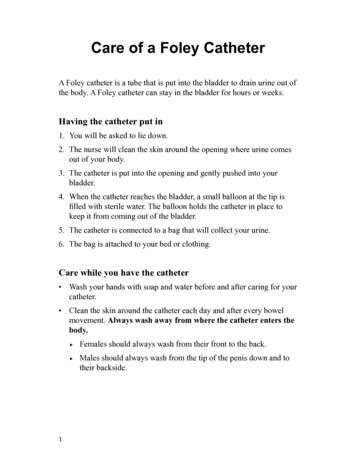
Transcription
Care of a Foley CatheterA Foley catheter is a tube that is put into the bladder to drain urine out ofthe body. A Foley catheter can stay in the bladder for hours or weeks.Having the catheter put in1. You will be asked to lie down.2. The nurse will clean the skin around the opening where urine comesout of your body.3. The catheter is put into the opening and gently pushed into yourbladder.4. When the catheter reaches the bladder, a small balloon at the tip isfilled with sterile water. The balloon holds the catheter in place tokeep it from coming out of the bladder.5. The catheter is connected to a bag that will collect your urine.6. The bag is attached to your bed or clothing.Care while you have the catheter Wash your hands with soap and water before and after caring for yourcatheter. Clean the skin around the catheter each day and after every bowelmovement. Always wash away from where the catheter enters thebody.ffff1Females should always wash from their front to the back.Males should always wash from the tip of the penis down and totheir backside.
Cuidado de un catéter de FoleyUn catéter de Foley es un tubo (sonda) que se coloca en la vejiga paradrenar la orina del cuerpo. Este catéter puede permanecer en la vejigadurante horas o semanas.Inserción del catéter1. Se le pedirá que se recueste.2. La enfermera limpiará la piel alrededor de la abertura por donde laorina sale del cuerpo.3. El catéter se insertará en la abertura y se empujará suavemente haciadentro de la vejiga.4. Cuando el catéter llegue a la vejiga, un pequeño globo en la punta sellenará con agua esterilizada. El globo mantiene el catéter en su lugary evita que se salga de la vejiga.5. El catéter se conecta a una bolsa que recolecta la orina.6. La bolsa se sujeta a la cama o a la ropa.Cuidados mientras tenga puesto el catéter Lávese las manos con agua y jabón antes y después de llevar a caboel cuidado del catéter. Limpie la piel alrededor del catéter todos los días y después de cadadeposición. Lávese siempre en dirección opuesta a la zona dondeel catéter ingresa al cuerpo.ffffLas mujeres deben lavarse siempre de adelante hacia atrás.Los hombres deben lavarse siempre desde la punta del pene haciaabajo y hacia atrás.Care of a Foley Catheter. Spanish.1
Keep the urine bag below waist level to prevent urine from flowingback into your bladder from the tubing and urine bag. Backflow ofurine can cause an infection. Wear cotton underwear to allow for air flow and drying in yourgenital area. Boxer shorts are often more comfortable to wear for bothmen and women. Drink at least 8 glasses of water or other liquids each day. Avoiddrinks with caffeine, such as tea, coffee and colas. Do not pull on the tubing. Do not step on the tubing when walking.You may want to clip or pin the tubing to your clothing. Make surethe safety pin goes around the catheter and not through it. Be sure to keep the bag below waist level. When getting into bed,hang the urine bag beside the bed or on the frame of the bed. Keep the tubing free of kinks or loops.2
Mantenga la bolsa de orina por debajo del nivel de la cintura paraevitar que la orina vuelva a la vejiga desde la bolsa y el tubo, ya queesto puede causar una infección. Use ropa interior de algodón para permitir la circulación de aire yel secado del área genital. A menudo, los calzoncillos bóxer son máscómodos, tanto para hombres como para mujeres. Beba al menos 8 vasos de agua u otros líquidos al día. Evite lasbebidas que contengan cafeína como el té, el café y las bebidas cola. No tire del tubo. No pise el tubo al caminar. Es aconsejable sujetarel tubo con una pinza o alfiler a la ropa. Asegúrese de que el alfilerrodee el catéter y no lo atraviese. Asegúrese de mantener la bolsa por debajo del nivel de la cintura.Al acostarse, cuelgue la bolsa de orina al costado de la cama o en elarmazón de ésta. Asegúrese de que el tubo no tenga pliegues ni curvaturas.Care of a Foley Catheter. Spanish.2
Only take the catheter and tubing apart to change the urine ectionBagDrainageCollectionBagHow to clean around your catheter1. Wash your hands with soap and water.2. Clean the skin near the catheter. Take a clean washcloth and moistenwith warm water and soap. Gently wash around your urinary opening.3. Hold the end of the catheter to keep it from being pulled. Washaround the catheter to remove any blood, crust or mucus, cleaningfrom near the body down the catheter. Never clean the cathetertowards your body because it may increase your chances of getting aninfection.4. Wash the area around your anus with a clean washcloth and warmwater.5. Rinse using another clean washcloth moistened with warm water.6. Pat the genital area dry with a clean towel.3
Solamente saque el catéter y el tubo para cambiar la bolsa de orina.Catéter deFoleyCatéter deFoleyCintaCintaBolsa derecolecciónde drenajeBolsa derecolecciónde drenajeCómo limpiar alrededor del catéter1. Lávese las manos con agua y jabón.2. Limpie la piel cerca del catéter. Tome un paño limpio y humedézcalo conagua tibia y jabón. Lave con cuidado alrededor de la abertura urinaria.3. Sostenga el extremo del catéter para evitar tirar de él. Lave alrededordel catéter para eliminar cualquier residuo de sangre, costras omucosidades. Para eso debe limpiar desde el cuerpo hacia el catéteren dirección descendente. Nunca limpie el catéter hacia su cuerpo, yaque puede aumentar las posibilidades de contraer una infección.4. Lave el área alrededor del ano con un paño limpio y agua tibia.5. Enjuague con otro paño limpio humedecido con agua tibia.6. Seque el área genital dando palmaditas con una toalla limpia.Care of a Foley Catheter. Spanish.3
7. Tape the catheter to your body to prevent it from being pulled out.Make sure there is enough tubing so the catheter will not be pulledwhen you move your leg.ffffWomen should tape the catheter to the upper leg.Men should tape the catheter to the lower abdomen or high on theleg so the catheter does not pull the penis downward.Measuring the urine from your urine bagEmpty the urine bag when it is ⅔ full or at least every 8 hours.1. If you are to record the amount of urine, place a measuring containeron the floor next to you. If you are not to keep a record of the amount,you can empty the urine into the toilet.2. Remove the drain spout from its holder on the bottom of the urinebag without touching its tip. Open the clamp on the spout.3. Let the urine flow out of the urine bag into the container or toilet. Donot let the drain tube touch anything.4. When the bag is empty, clean the end of the drain spout with waterand tissue. Close the clamp and put the drain spout into its holder atthe bottom of the urine bag.5. If you are to measure the amount, record how much urine is in thecontainer. Empty the measuring container into the toilet. Rinse thecontainer with clean water.Changing and cleaning your urine bag1. Get a new or clean urine bag with tubing.2. Put a clamp on the catheter tubing near the end that connects to theurine bag tube.3. Remove the catheter from the tubing to the old bag.4. Clean the ends of the new bag tubing and catheter with alcohol beforeputting them back together.4
7. Sujete el catéter con cinta adhesiva a su cuerpo para evitar tirar de él.Asegúrese de que el tubo sea suficientemente largo para no tirar delcatéter al mover la pierna.ffffLas mujeres deben adherir el catéter a la parte superior de lapierna.Los hombres deben adherir el catéter a la parte inferior delabdomen o a la parte superior de la pierna, para que el catéter notire del pene hacia abajo.Medición de la orina en la bolsa de orinaVacíe la bolsa de orina cuando esté ⅔ llena o al menos cada 8 horas.1. Si va a registrar la cantidad de orina, coloque un envase graduadoen el suelo cerca suyo. Si no va a hacerlo, puede vaciar la orina en elinodoro.2. Retire la boquilla de drenaje de su soporte en la base de la bolsa deorina sin tocar la punta. Abra la pinza de la boquilla.3. Deje que la orina caiga en el envase o en el inodoro. No deje quenada toque el tubo de drenaje.4. Cuando la bolsa esté vacía, limpie el extremo de la boquilla dedrenaje con agua y pañuelos de papel. Cierre la pinza y coloque laboquilla de drenaje en su soporte en la base de la bolsa de orina.5. Si va a medir la cantidad, registre cuánta orina hay en el envase.Vacíe el envase graduado en el inodoro. Enjuáguelo con agua limpia.Cambio y limpieza de la bolsa de orina1. Obtenga una bolsa de orina nueva o limpia con tubo.2. Coloque una pinza en el tubo del catéter cerca del extremo queconecta al tubo de la bolsa de orina.3. Retire el catéter del tubo de la bolsa antigua.4. Limpie con alcohol los extremos del tubo de la bolsa nueva y delcatéter antes de volver a unirlos.Care of a Foley Catheter. Spanish.4
5. Connect the catheter to the new bag.6. Open the clamp on the catheter tubing.7. Rinse the old bag with warm water.8. Fill the bag with 2 parts white vinegar to 3 parts tap water. Leave thewater and vinegar mixture in the bag for at least 20 minutes. You mayuse chlorine bleach instead of the vinegar.9. Empty and rinse the bag. Hang it upside down and let it air dry.10. When the bag is dry, store it in a clean plastic bag until you are readyto use it again.Removing your catheterYour doctor or nurse will remove your catheter when it is no longerneeded. A syringe will be used to remove the water from the ballooninside your bladder. The catheter will then be gently pulled out.Problem Solving If your catheter is not draining:ffCheck to see if the tubing is twisted or bent.ffSee if you are lying on the catheter or tubing.ffMake sure the urine bag is below waist level. If your catheter comes out or is leaking:5ffPlace a towel or waterproof pad under you.ffDo not try to put the catheter back in.
5. Conecte el catéter a la bolsa nueva.6. Abra la pinza del tubo del catéter.7. Enjuague la bolsa usada con agua tibia.8. Llene la bolsa con 2 partes de vinagre blanco por 3 partes de agua delgrifo. Deje la mezcla de agua y vinagre en la bolsa durante al menos20 minutos. Puede usar blanqueador de cloro en vez de vinagre.9. Vacíe y enjuague la bolsa. Cuélguela al revés y déjela secar al aire.10. Cuando esté seca, guárdela en una bolsa plástica limpia hasta que estélisto para volver a usarla.Retiro del catéterSu médico o enfermera le retirará el catéter cuando ya no sea necesario.Se usará una jeringa para extraer el agua del globo dentro de su vejiga.Luego se retirará el catéter con cuidado.Solución de problemas Si el catéter no drena:ffCompruebe que el tubo no esté torcido o doblado.ffCompruebe que no esté recostado sobre el catéter o el tubo.ffAsegúrese de que la bolsa de orina esté por debajo del nivel de lacintura. Si el catéter se sale o tiene filtraciones:ffColoque una toalla o protector impermeable debajo suyo.ffNo intente volver a colocarse el catéter.Care of a Foley Catheter. Spanish.5
Call your doctor or nurse right away if: Your catheter comes out or is leaking. Your urine changes to be thick or more cloudy, or there is moremucus or blood in it. Your urine has a strong, foul odor. No urine has drained from your catheter in 6 to 8 hours. You have pain or burning near the catheter or in your bladder,abdomen or lower back. You have shaking or chills or your temperature is over 100.5 degreesF or 38 degrees C.Talk to your doctor or nurse if you have any questions or concerns.2005 – 9/2011 Health Information TranslationsUnless otherwise stated, user may print or download information from www.healthinfotranslations.org for personal, non-commercial use only. The medical informationfound on this website should not be used in place of a consultation with your doctor or other health care provider. You should always seek the advice of your doctor orother qualified health care provider before you start or stop any treatment or with any questions you may have about a medical condition. The Ohio State UniversityMedical Center, Mount Carmel Health System, OhioHealth and Nationwide Children’s Hospital are not responsible for injuries or damages you may incur as a result ofyour stopping medical treatment or your failure to obtain medical treatment.6
Llame a su médico o enfermera de inmediato si: El catéter se sale o tiene filtraciones. La orina se hace espesa o más opaca, o si hay más mucosidades osangre en ella. La orina tiene un muy mal olor. No se ha drenado orina del catéter en las últimas 6 a 8 horas. Tiene dolor o ardor cerca del catéter o en la vejiga, el abdomen o laparte baja de la espalda. Tiene temblores o escalofríos o su temperatura es superior a100.5 grados F o 38 grados C.Hable con su médico o enfermera si tiene alguna pregunta o inquietud.2005 – 9/2011 Health Information TranslationsUnless otherwise stated, user may print or download information from www.healthinfotranslations.org for personal, non-commercial use only. The medical informationfound on this website should not be used in place of a consultation with your doctor or other health care provider. You should always seek the advice of your doctor orother qualified health care provider before you start or stop any treatment or with any questions you may have about a medical condition. The Ohio State UniversityMedical Center, Mount Carmel Health System, OhioHealth and Nationwide Children’s Hospital are not responsible for injuries or damages you may incur as a result ofyour stopping medical treatment or your failure to obtain medical treatment.Care of a Foley Catheter. Spanish.6
Care of a Foley Catheter A Foley catheter is a tube that is put into the bladder to drain urine out of the body. A Foley catheter can stay in the bladder for hours or weeks. Having the catheter put in 1. You will be asked to lie down. 2. The nurse will clean the skin around the opening where urine comes out of your body. 3.



